I have been asked to review a couple of new Li-ion battery chargers by Xtar. Although I don't have the experience or expertise of others here, I've agreed to compare them to the 3 chargers I keep on hand for regular use: the standard Pila charger, the classic DSD charger, and the basic-model Cytac/HXY/DealExtreme.6105 charger.
For more info on chargers in general – and some excellent detailed comparisons – I recommend you check out the excellent mdocod's consumer Li-Ion cradle charger roundup review.
To start with, here are the WP2 specifications:
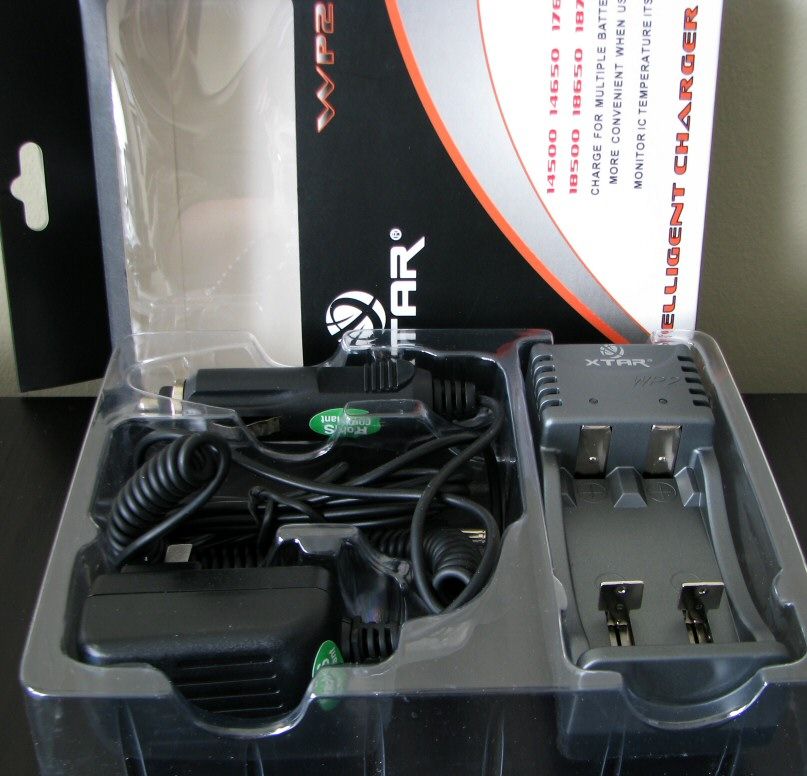
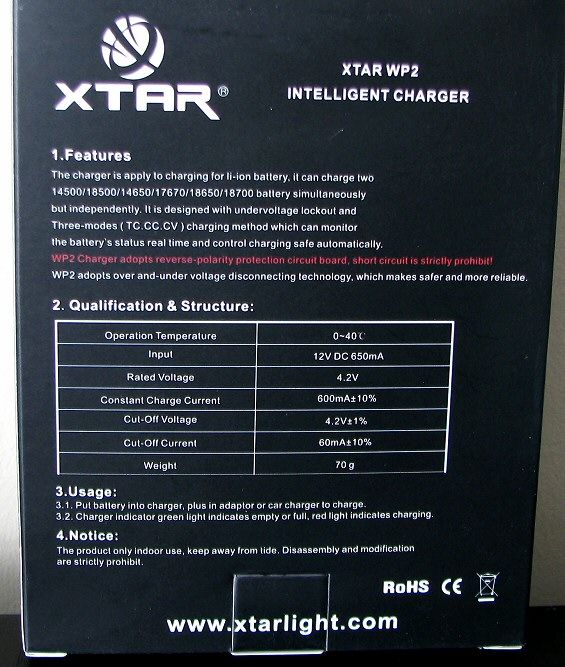
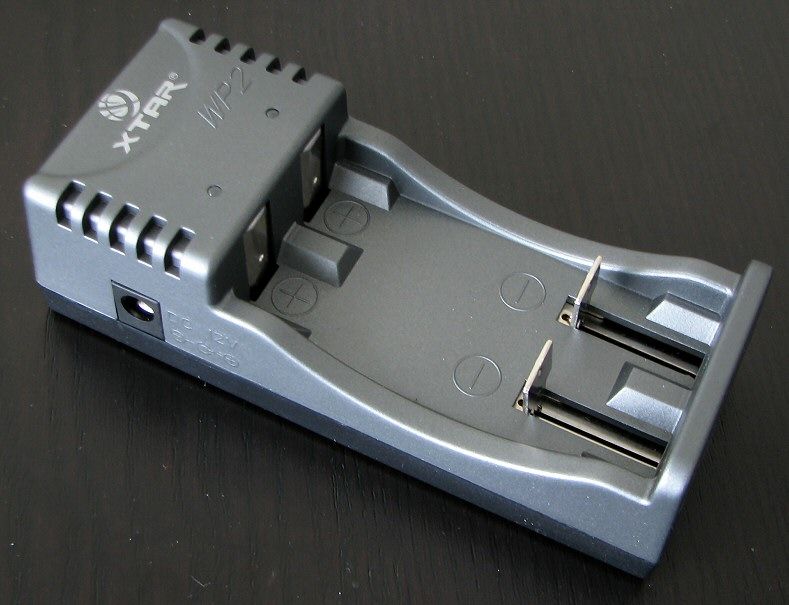
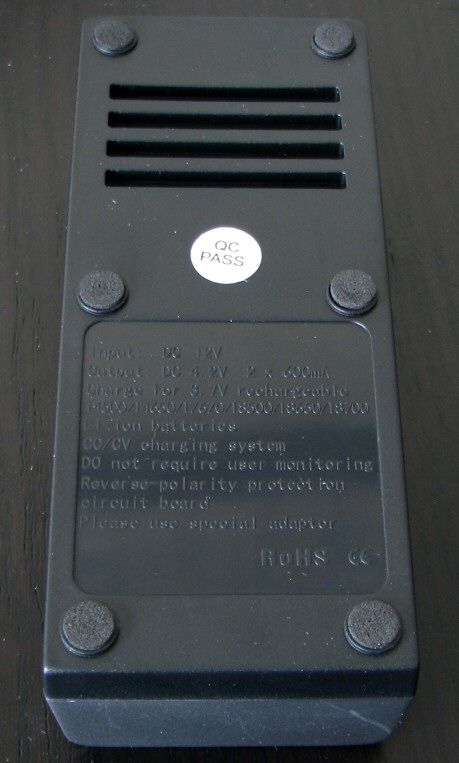
The WP2 comes with both standard AC power adapter and DC car adapter. The cabling and overall build seem reasonably good (good length on the cables, reasonably solid, etc.). The battery trays are spring-mounted, and can easily accommodate any size from 14500-18650.
And now the MP1 specifications:

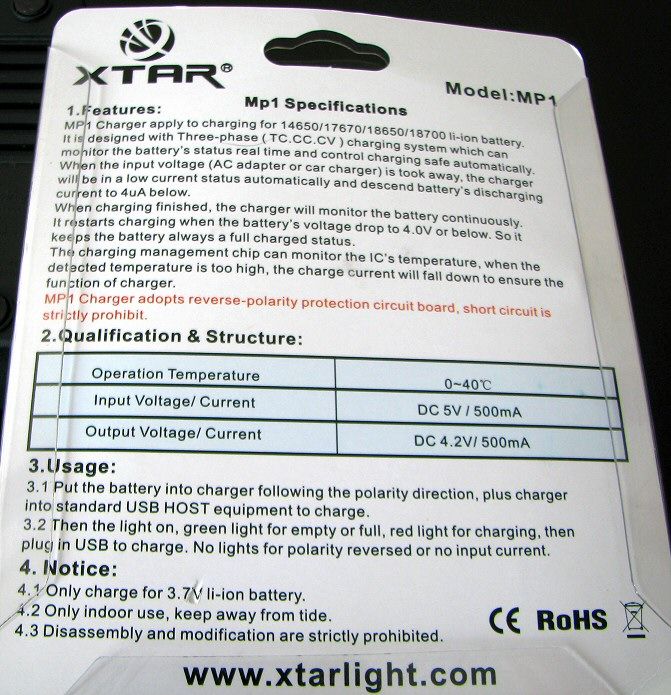
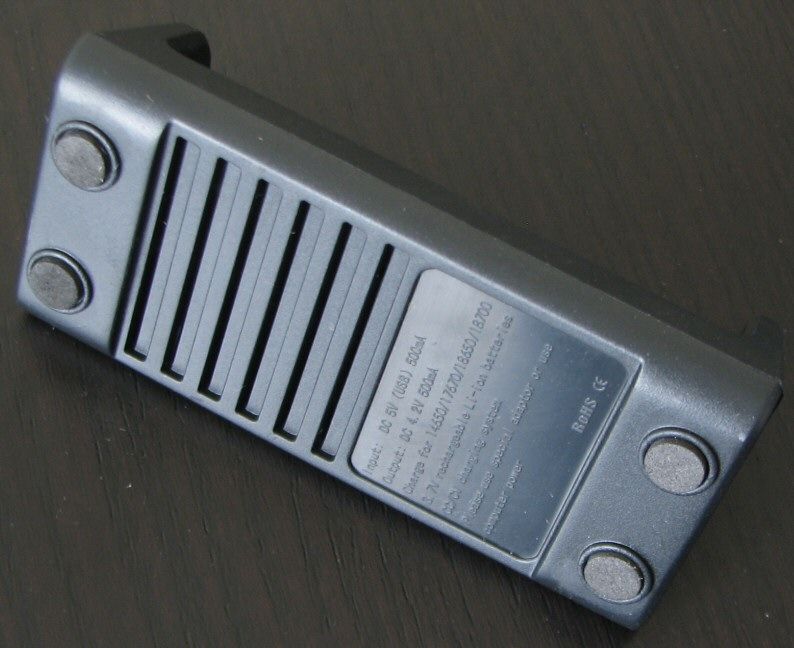
The MP1 is a much simpler package, consisting of the charging base and a short standard micro-USB/USB charging cable. Also included with my review sample were a USB-to-AC adapter and a USB-to-DC adapter.
Note that the bundled USB cable length is rather short. But since it uses the standard micro-USB connector at the charging cradle end, you should be able to use a longer one from one of your other devices (e.g. camera, blackberry, etc.).
I note that the specifications for the two chargers seem similar – but the MP1 also specifically notes that the charger will monitor the cell once fully charged, and maintain a low 4uA charging current. I have heard similar claims made for the WP2, but don't see that on their spec sheet.
For the charging comparisons, here are the 3 chargers I routinely use:
Pila charger:
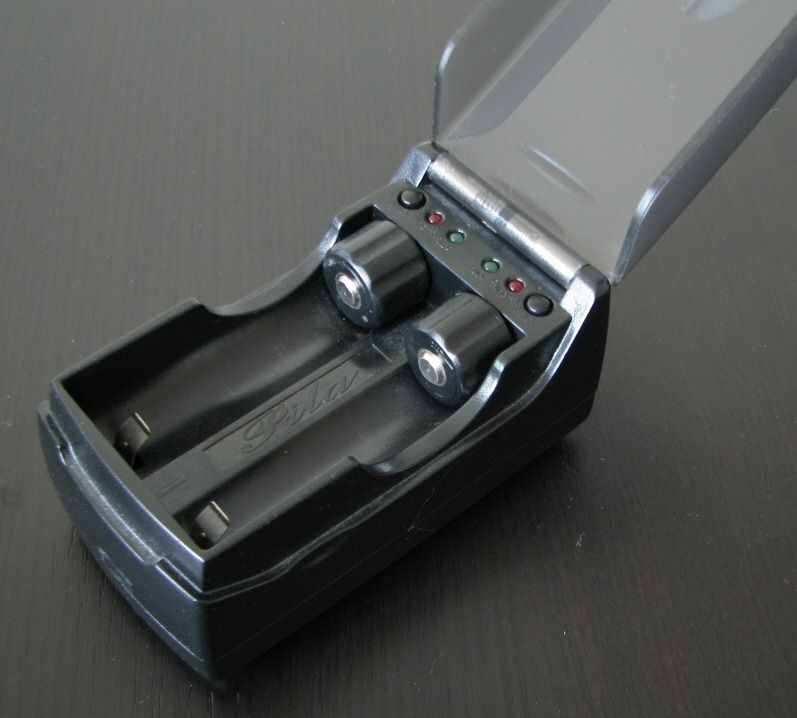
The Pila charger is probably the "standard" by which all Li-ion chargers are judged. Well designed, it uses a proper Constant-Current/Constant-Voltage charging regimen with proper termination (i.e. current shuts off once the cell reaches full charge). Features two independent channels. You can also top-up your nearly-full cells by manually forcing a charge (i.e. most chargers won't charge cells that exceed ~4.0V).
With the bundled spacers, you can charge everything from 14500 and up. Although the Pila will also charge 16340 (RCR) with additional spacers, this really isn't the ideal charger for them (i.e. the charge and cut-off current may be a bit high for them). However, the Pila should be reasonably safe on RCR thanks to its "intelligent" charging algorithm.
DSD charger:
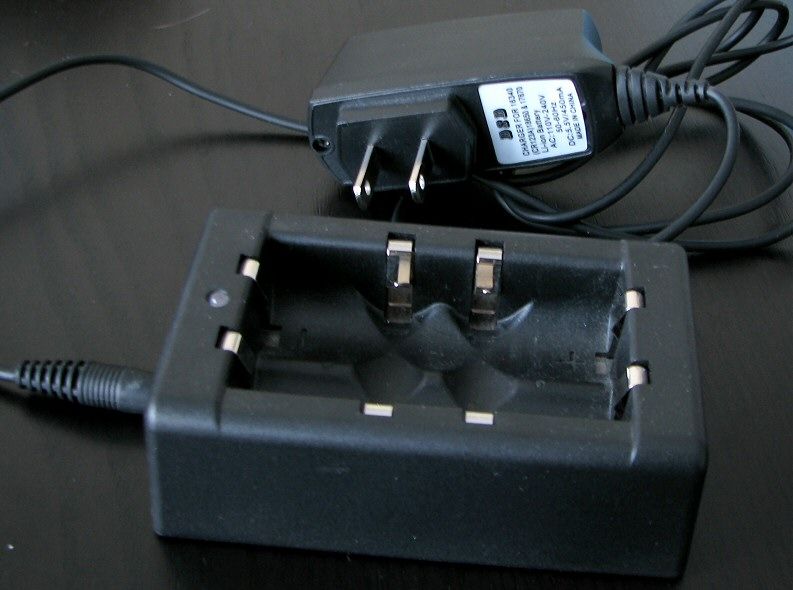
Despite appearances, this is actually a single-channel charger (i.e. it is wired for 2 cells in parallel, for simultaneous charging). Simple and basic, it is fairly popular for its Constant Current charging method, followed by true termination (i.e. no trickle charge). Main drawback is its slow rated charge rate (~350mA), and no CV stage.
DX.6105 charger:
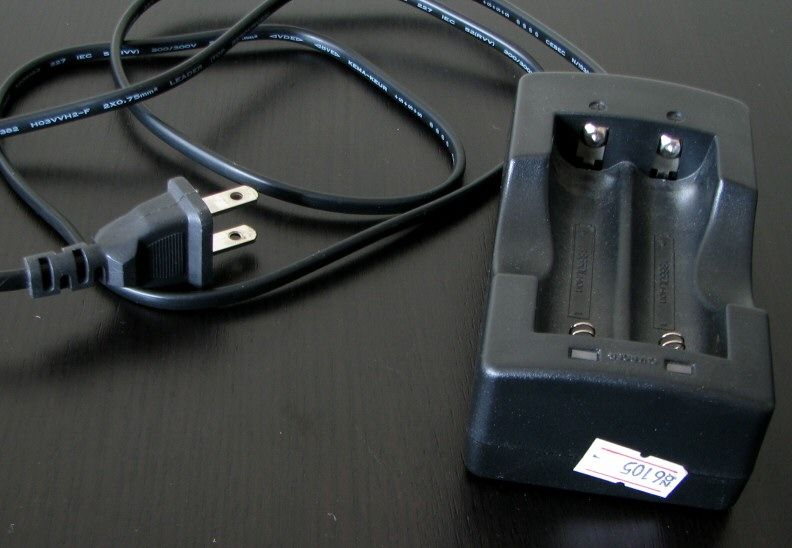
I often use the common DX 6105 2x18650 charger shown above (aka Cytac or HXY charger) for the first part of my 18650 charging regimen. The reason for this will limited role will become clear with the charging summary graph below.
Although capable of charging at a higher rate, it lack any sort of Constant Current or Constant Voltage charging method, and doesn't terminate at the end of a charge (i.e. just slowly drops off in charge, even after the light goes green). It does feature two independent channels, though.
CHARGER COMPARISONS
To compare the performance of the chargers, I have directly monitored their charging currents with a data-logging DMM. I have used the measuring method described by HKJ in his excellent Measurement on flashlight overview, for measuring charge current on Li-ion chargers.
For these tests, I have used one of my standard AW protected 18650 (2200mAh) cells. To deplete the cell, I used my regular test bed of a fully-regulated JetBeam Jet-III IBS on Max output – and waited until the cell's protection circuit was tripped. The cell was then immediately loaded into the charger for testing and recording (i.e. depleted resting voltage typically ~3V).
The graph below is complicated, so let me walk you through each trace.
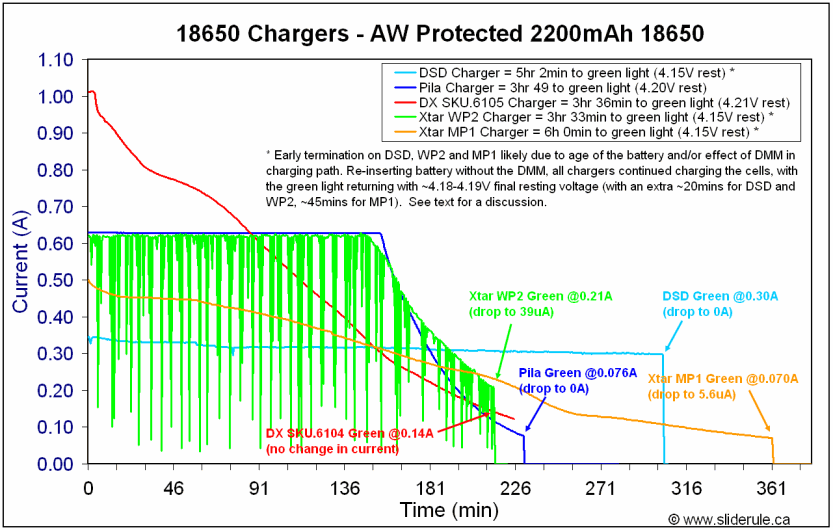
First off – a note about the early termination on three of the chargers (i.e. ~4.15V on the DSD, WP2, and MP1). I believe this is due to a combination of effects – notably the age of the cell used in testing (one of my "retired" 18650s with a lot of charging cycles on it), and the presence of the DMM in the charging path.
Even though this current-charging measurement setup has a relatively low impedance and a low voltage drop, it still seems to confuse the charger termination when older cells are used. In all three of these cases, when I re-inserted the cell without the DMM, the charging light went red again, and continued until ~4.18-4.19V resting volts. But if I reconnected with the DMM in place, the light stayed green and wouldn't charge further (strongly suggesting the DMM plays a role in the issue).
Testing further, I noticed these three chargers were variable in their termination points even without the DMM in place. Basically, new cells all terminated ~4.18-4.19V resting volts. But older cells, with a lot cycles on them, terminated anywhere from ~4.13-4.16V resting volts. In each of those cases, re-inserting the cell caused charging to continue (although not necessarily all the way up to 4.19V resting volts, depending on how old the cell was).
Take home message – recycle your old cells once they get a lot of charges on them (i.e >100 cycles).
SUMMARY OF FINDINGS
Pila charger: The Pila curve above is exactly what you want to see. The charger runs initially at a constant-current (~630mA in my case) for ~2.5 hours, and then switches to a constant-voltage mode for the last ~1.5 hour of charging. When the cell is fully charged, the charging light turns green and the current drops to zero. At this point, I pulled out the cell and it read 4.20V resting voltage (i.e. fully charged). Perfect. : thumbsup:
DSD charger: The DSD charger has a fairly constant charging current - ~0.35A at the start of my run, slowly dropped to ~0.30A when the light went green and it terminated the charge 5+ hours later. Note the early termination in my tests (explained above).
DX.6105 charger: The DX.6105 does not use a constant-current method, but simply starts at a high current and gradually drops off (mine started just over 1A, although some have reported lower initial currents, e.g. ~0.75A). Note that the unit does not terminate once the light goes green, but continues to charge at a low rate (140mA and dropping, in my case). This is NOT recommended – 140mA is still a lot of current, and you will quickly over-charge your cells if you do not IMMEDIATELY pull them out of the charger. This is really bad on Li-ions. :shakehead: 10mins after the light went green, resting voltage was 4.21V on my sample.
Xtar WP2 charger: Although the trace looks a little strange, the WP2 is similar to the Pila in its CC/CV algorithm. For some reason, my DMM kept reporting a drop in current, for a fraction of a second every 2-3 secs or so (which is what gives you that strange looking trace above :thinking . Like the DSD charger, early termination was noted on my admittedly old cell (see explanatory note above)
. Like the DSD charger, early termination was noted on my admittedly old cell (see explanatory note above)
Note that the WP2 does not actually completely terminate when the light goes green. Although my DMM dropped to zero on my 10A port, when I switched to my DMM's mA/uA port, I could detect a low current of 39uA. Again, every few seconds or so, it would briefly jump up to a slightly larger current (up to a max of ~300uA). Not sure what this means, but it may be a sign of the monitoring current reported for the WP2. In any case, this low uA current is not likely to be a problem for the cell (i.e. nowhere near as bad as the mA currents of "trickle chargers"). :shrug:
My main concern here is the relatively high charging rate at the time of termination (i.e. >200mA). That's pretty high, and wouldn't be the best for smaller cells with lower capacity. So while you could fit RCR (16340) in the WP2 with a standard length spacer, this is not the ideal charger for these cells.
WP1 charger: The WP1 starts off at its rated 0.5A charging current. But it doesn't seem to be a proper CC/CV charger as claimed. Rather, the charging current drops off to around 0.45A reasonably quickly (over ~10 mins) and then seems to slowly decay over time, until it reaches a fully charged state.:shrug: Like the DSD and WP2, the MP1 showed early termination on my older 18650 cell (see note above).
At the point when the light goes green, the current drops to an ultra-low 5.6uA. This is consistent with what Xtar reports for the MP1 – i.e. drops to a low current (4uA claimed), while it continues to monitor the charge state of the cell. It will supposedly then periodically increases the current, to keep the battery fully topped-up. Up to you if you want such a feature, but this ultra-low uA current shouldn't be a problem.
Preliminary Discussion:
I will preface my comments by making it clear up-front that I am not an expert on battery chemistry or charging methods. There are many more here with infinitely more experience and knowledge of these matters, and I defer to them for any interpretation of the results. :bow:
From my (limited) perspective, the Xtar WP2 seems like a pretty good "poor man's" Pila, (although it lacks the Pila's ability to force a manual charge). Overall performance and the charging algorithm seem very similar (although the WP2 terminates at a higher ~200mA current). For the estimated street price of ~$20 (shipping included), you certainly get decent value for your money. Definitely much better performance than a lot of the cheap "trickle"chargers out there!
The MP1 doesn't live up to its claimed CC/CV charging method, but I suppose the overall performance is reasonable for the price point of ~$10. You also have the option of running off USB, AC or DC power. Note that I never recommend running a sustained charging system off a computer's USB port – best to stick with AC/DC power. As such, I'm glad to see the adapters included on my sample.
As for termination, I personally can't stand chargers that don't properly terminate when the light goes green (e.g my DX.6105). That being said, I'm not overly concerned about the ultra-low uA monitoring charge on both of the Xtar chargers – for all intents and purposes, charging of the cells really stops at this point. But as with all chargers, I recommend you pull the cells out once the light goes green.
That being said, I'm not overly concerned about the ultra-low uA monitoring charge on both of the Xtar chargers – for all intents and purposes, charging of the cells really stops at this point. But as with all chargers, I recommend you pull the cells out once the light goes green. 
I welcome any comments or suggestions on my analysis above. :wave:
UPDATE Jan 26, 2010: To allow you better compare the Xtar chargers, below are direct comparisons of the charging current vs charging voltage for each charger, on the same battery (a well-used AW 18650 2200mAh). The blue scale on the left is the charging current, the purple scale on the right is the charging voltage.
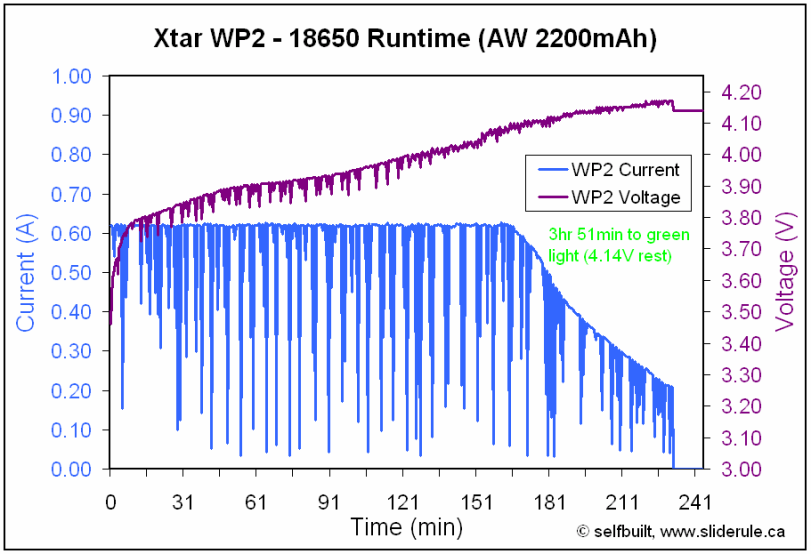
As expected, the WP2 shows periodic dips in the charging voltage every 2-3 secs (i.e. just like you see for the charging current). The magnitude of the voltage deflection is a lot less though - I never saw more than ~70mV variance from expected.
Once the light when green and the charger quasi-terminated, the voltage dropped to the resting level of 4.14V.
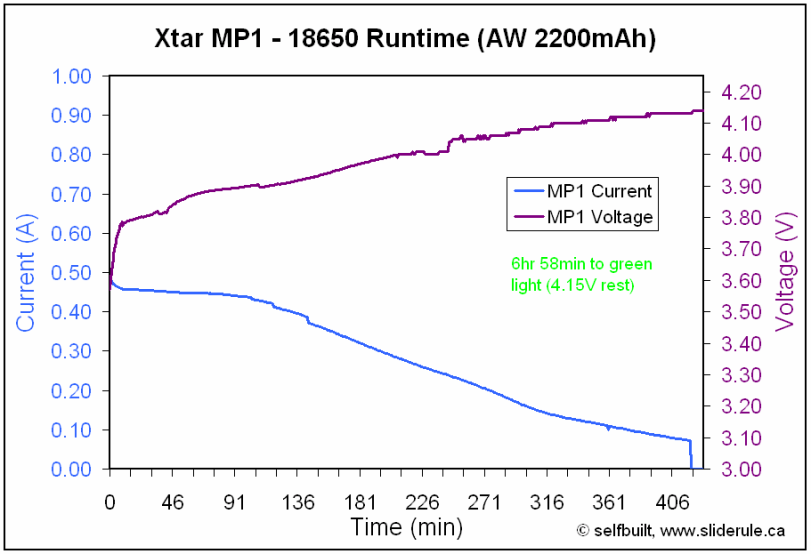
The voltage trace of the MP1 is about what you would expect. I don't know what algorithm the charger is using exactly, but there were no unexpected major jumps/dips in charging voltage. Thanks to the low (<70mA) charging current when the charger terminated, there's no significant change in the resting/charging voltage (i.e. ends at around 4.15V).
Hope that was helpful!
----
Xtar WP2 and MP1 provided by Xtar for review. All other chargers were personally purchased several years ago.
For more info on chargers in general – and some excellent detailed comparisons – I recommend you check out the excellent mdocod's consumer Li-Ion cradle charger roundup review.
To start with, here are the WP2 specifications:
- Two independent charging channels for 14500/ 18500/ 14650/ 17670/ 18650/ 18700 Li-ion battery
- Undervoltage lockout system
- Algorithm ( CC.CV ) charging system
- Reverse-polarity protection circuit board
- Under voltage disconnecting technology
- Operation Temperature: Room temperature 0~40℃
- Input AC: 12V DC 650mA
- Rated Voltage: 4.2V
- Constant Charge Current: 600mA±10%
- Constant Charge Voltage: 4.2V±1%
- Cut-Off Current: 60mA±10%
- Weight: 70g
- Can be found on discount websites/eBay for ~$20, shipping included




The WP2 comes with both standard AC power adapter and DC car adapter. The cabling and overall build seem reasonably good (good length on the cables, reasonably solid, etc.). The battery trays are spring-mounted, and can easily accommodate any size from 14500-18650.
And now the MP1 specifications:
- 14650/17670/18650/18700 Li-ion battery charging
- Standard USB charging interface
- Algorithm charging system (CC/CV), real-time battery monitoring system
- IC temperature monitoring system
- High and low voltage separated charging system
- Input: DC 5V 500mA
- Output: DC 4.2V 500mA
- Constant charge current:500mA±10%
- Constant charge voltage:4.2V±1%
- Adaptor input: 110V~240V AC 50/60Hz
- Adaptor output: DC 5V 500mA
- Operation temperature: 0℃~40℃
- Car Adaptor output: DC 5V
- Can be found on discount websites/eBay for ~$10, shipping included



The MP1 is a much simpler package, consisting of the charging base and a short standard micro-USB/USB charging cable. Also included with my review sample were a USB-to-AC adapter and a USB-to-DC adapter.
Note that the bundled USB cable length is rather short. But since it uses the standard micro-USB connector at the charging cradle end, you should be able to use a longer one from one of your other devices (e.g. camera, blackberry, etc.).
I note that the specifications for the two chargers seem similar – but the MP1 also specifically notes that the charger will monitor the cell once fully charged, and maintain a low 4uA charging current. I have heard similar claims made for the WP2, but don't see that on their spec sheet.
For the charging comparisons, here are the 3 chargers I routinely use:
Pila charger:

The Pila charger is probably the "standard" by which all Li-ion chargers are judged. Well designed, it uses a proper Constant-Current/Constant-Voltage charging regimen with proper termination (i.e. current shuts off once the cell reaches full charge). Features two independent channels. You can also top-up your nearly-full cells by manually forcing a charge (i.e. most chargers won't charge cells that exceed ~4.0V).
With the bundled spacers, you can charge everything from 14500 and up. Although the Pila will also charge 16340 (RCR) with additional spacers, this really isn't the ideal charger for them (i.e. the charge and cut-off current may be a bit high for them). However, the Pila should be reasonably safe on RCR thanks to its "intelligent" charging algorithm.
DSD charger:

Despite appearances, this is actually a single-channel charger (i.e. it is wired for 2 cells in parallel, for simultaneous charging). Simple and basic, it is fairly popular for its Constant Current charging method, followed by true termination (i.e. no trickle charge). Main drawback is its slow rated charge rate (~350mA), and no CV stage.
DX.6105 charger:

I often use the common DX 6105 2x18650 charger shown above (aka Cytac or HXY charger) for the first part of my 18650 charging regimen. The reason for this will limited role will become clear with the charging summary graph below.
Although capable of charging at a higher rate, it lack any sort of Constant Current or Constant Voltage charging method, and doesn't terminate at the end of a charge (i.e. just slowly drops off in charge, even after the light goes green). It does feature two independent channels, though.
CHARGER COMPARISONS
To compare the performance of the chargers, I have directly monitored their charging currents with a data-logging DMM. I have used the measuring method described by HKJ in his excellent Measurement on flashlight overview, for measuring charge current on Li-ion chargers.
For these tests, I have used one of my standard AW protected 18650 (2200mAh) cells. To deplete the cell, I used my regular test bed of a fully-regulated JetBeam Jet-III IBS on Max output – and waited until the cell's protection circuit was tripped. The cell was then immediately loaded into the charger for testing and recording (i.e. depleted resting voltage typically ~3V).
The graph below is complicated, so let me walk you through each trace.

First off – a note about the early termination on three of the chargers (i.e. ~4.15V on the DSD, WP2, and MP1). I believe this is due to a combination of effects – notably the age of the cell used in testing (one of my "retired" 18650s with a lot of charging cycles on it), and the presence of the DMM in the charging path.
Even though this current-charging measurement setup has a relatively low impedance and a low voltage drop, it still seems to confuse the charger termination when older cells are used. In all three of these cases, when I re-inserted the cell without the DMM, the charging light went red again, and continued until ~4.18-4.19V resting volts. But if I reconnected with the DMM in place, the light stayed green and wouldn't charge further (strongly suggesting the DMM plays a role in the issue).
Testing further, I noticed these three chargers were variable in their termination points even without the DMM in place. Basically, new cells all terminated ~4.18-4.19V resting volts. But older cells, with a lot cycles on them, terminated anywhere from ~4.13-4.16V resting volts. In each of those cases, re-inserting the cell caused charging to continue (although not necessarily all the way up to 4.19V resting volts, depending on how old the cell was).
Take home message – recycle your old cells once they get a lot of charges on them (i.e >100 cycles).
SUMMARY OF FINDINGS
Pila charger: The Pila curve above is exactly what you want to see. The charger runs initially at a constant-current (~630mA in my case) for ~2.5 hours, and then switches to a constant-voltage mode for the last ~1.5 hour of charging. When the cell is fully charged, the charging light turns green and the current drops to zero. At this point, I pulled out the cell and it read 4.20V resting voltage (i.e. fully charged). Perfect. : thumbsup:
DSD charger: The DSD charger has a fairly constant charging current - ~0.35A at the start of my run, slowly dropped to ~0.30A when the light went green and it terminated the charge 5+ hours later. Note the early termination in my tests (explained above).
DX.6105 charger: The DX.6105 does not use a constant-current method, but simply starts at a high current and gradually drops off (mine started just over 1A, although some have reported lower initial currents, e.g. ~0.75A). Note that the unit does not terminate once the light goes green, but continues to charge at a low rate (140mA and dropping, in my case). This is NOT recommended – 140mA is still a lot of current, and you will quickly over-charge your cells if you do not IMMEDIATELY pull them out of the charger. This is really bad on Li-ions. :shakehead: 10mins after the light went green, resting voltage was 4.21V on my sample.
Xtar WP2 charger: Although the trace looks a little strange, the WP2 is similar to the Pila in its CC/CV algorithm. For some reason, my DMM kept reporting a drop in current, for a fraction of a second every 2-3 secs or so (which is what gives you that strange looking trace above :thinking
Note that the WP2 does not actually completely terminate when the light goes green. Although my DMM dropped to zero on my 10A port, when I switched to my DMM's mA/uA port, I could detect a low current of 39uA. Again, every few seconds or so, it would briefly jump up to a slightly larger current (up to a max of ~300uA). Not sure what this means, but it may be a sign of the monitoring current reported for the WP2. In any case, this low uA current is not likely to be a problem for the cell (i.e. nowhere near as bad as the mA currents of "trickle chargers"). :shrug:
My main concern here is the relatively high charging rate at the time of termination (i.e. >200mA). That's pretty high, and wouldn't be the best for smaller cells with lower capacity. So while you could fit RCR (16340) in the WP2 with a standard length spacer, this is not the ideal charger for these cells.
WP1 charger: The WP1 starts off at its rated 0.5A charging current. But it doesn't seem to be a proper CC/CV charger as claimed. Rather, the charging current drops off to around 0.45A reasonably quickly (over ~10 mins) and then seems to slowly decay over time, until it reaches a fully charged state.:shrug: Like the DSD and WP2, the MP1 showed early termination on my older 18650 cell (see note above).
At the point when the light goes green, the current drops to an ultra-low 5.6uA. This is consistent with what Xtar reports for the MP1 – i.e. drops to a low current (4uA claimed), while it continues to monitor the charge state of the cell. It will supposedly then periodically increases the current, to keep the battery fully topped-up. Up to you if you want such a feature, but this ultra-low uA current shouldn't be a problem.
Preliminary Discussion:
I will preface my comments by making it clear up-front that I am not an expert on battery chemistry or charging methods. There are many more here with infinitely more experience and knowledge of these matters, and I defer to them for any interpretation of the results. :bow:
From my (limited) perspective, the Xtar WP2 seems like a pretty good "poor man's" Pila, (although it lacks the Pila's ability to force a manual charge). Overall performance and the charging algorithm seem very similar (although the WP2 terminates at a higher ~200mA current). For the estimated street price of ~$20 (shipping included), you certainly get decent value for your money. Definitely much better performance than a lot of the cheap "trickle"chargers out there!
The MP1 doesn't live up to its claimed CC/CV charging method, but I suppose the overall performance is reasonable for the price point of ~$10. You also have the option of running off USB, AC or DC power. Note that I never recommend running a sustained charging system off a computer's USB port – best to stick with AC/DC power. As such, I'm glad to see the adapters included on my sample.
As for termination, I personally can't stand chargers that don't properly terminate when the light goes green (e.g my DX.6105).
I welcome any comments or suggestions on my analysis above. :wave:
UPDATE Jan 26, 2010: To allow you better compare the Xtar chargers, below are direct comparisons of the charging current vs charging voltage for each charger, on the same battery (a well-used AW 18650 2200mAh). The blue scale on the left is the charging current, the purple scale on the right is the charging voltage.

As expected, the WP2 shows periodic dips in the charging voltage every 2-3 secs (i.e. just like you see for the charging current). The magnitude of the voltage deflection is a lot less though - I never saw more than ~70mV variance from expected.
Once the light when green and the charger quasi-terminated, the voltage dropped to the resting level of 4.14V.

The voltage trace of the MP1 is about what you would expect. I don't know what algorithm the charger is using exactly, but there were no unexpected major jumps/dips in charging voltage. Thanks to the low (<70mA) charging current when the charger terminated, there's no significant change in the resting/charging voltage (i.e. ends at around 4.15V).
Hope that was helpful!
----
Xtar WP2 and MP1 provided by Xtar for review. All other chargers were personally purchased several years ago.
Last edited:



 This applies not only to LiCo Li-Ion cells, but all the other chemistries of Li-Ion cells as well. Although LiMn and LiFe Li-Ion cells are likely to be somewhat less "exciting", these too, could vent if a bad cell were to over heat while charging. This is why it is always recommended to never leave Li-Ion cells charging while unattended. The chances of an incident are relatively low, but why take a chance?
This applies not only to LiCo Li-Ion cells, but all the other chemistries of Li-Ion cells as well. Although LiMn and LiFe Li-Ion cells are likely to be somewhat less "exciting", these too, could vent if a bad cell were to over heat while charging. This is why it is always recommended to never leave Li-Ion cells charging while unattended. The chances of an incident are relatively low, but why take a chance?